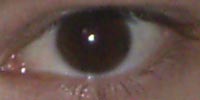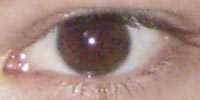Ricoh Caplio R1
Review Date: November 15th 2004
|
Image Quality
All of the sample images in this Review were taken using the default 4 megapixel 2304 x 1728 mode, which gives an average image size of around 1-1.5Mb.
Noise
There are 5 ISO settings available on the Ricoh Caplio R1 which you can select at any time. Here are some 100% crops which show the noise levels for each ISO setting:
ISO 64 (100% crop) |
ISO 100 (100% crop) |
 |
 |
ISO 200 (100% crop) |
ISO 400 (100% crop) |
 |
 |
ISO 800 (100% crop) |
|
 |
|
The noise levels look very good at ISOs 50 and 100, with some noise starting to appear at ISO 200. By ISOs 400 and 800 the quality has deteriorated, but they are still quite useable, so overall a good performance from the Ricoh Caplio R1.
Sharpening
Here are two 100% crops which have been Saved as Web - Quality 50 in Photoshop. The right-hand image has had some sharpening applied in Photoshop. The original images were taken with the Sharpness option set to Normal. They are quite soft out of the camera and definitely benefit from being sharpened in Photoshop or a similar application. Alternatively you could change the Sharpness option to the most aggressive setting, Sharp.
Original 100% Crop |
Sharpened 100% Crop |
 |
 |
 |
 |
File Quality
The Ricoh Caplio R1 has 7 different image sizes and compression levels available, with F2304 (2,304 x 1,768) being the default option. Here are some 100% crops which show the various sizes.
F2304 (2304 x 1768) |
N2304 (2304 x 1768) |
 |
 |
F1600 (1600 x 1200) |
N1600 (1600 x 1200) |
 |
 |
F1280 (1280 x 960) |
N1280 (1280 x 960) |
 |
 |
N640 (3,224 x 2,448) |
|
 |
|
Chromatic Aberrations
Unlike previous Ricoh cameras that I have reviewed, the Ricoh Caplio R1 dealt extremely well with chromatic aberrations, so much so that I struggled to find any examples amongst the images that I took for this review! You can just see a hint of purple fringing in the crop below, but overall the camera produced images that exhibited very few chromatic aberrations.
 |
Macro
The Ricoh Caplio R1 has an industry-leading Macro setting that allows you to focus on a subject that is just 1cm away from the camera. This does introduce other problems, such as the shadow of the camera getting in the picture, and softness in some parts of the image if a large aperture is chosen by the camera (as in the example below).
Macro Shot (click to view full-sized image) |
100% Crop |
The first image shows how close you can get to the subject whilst still being able to auto-focus (in this case a compact flash card). The second image is a 100% crop.
Flash
The flash settings on the Ricoh Caplio R1 are standard on most digital cameras - Auto, Red-eye Reduction, On, Slow Synchro, Off. These shots of a white wall were taken at a distance of 1.5m.
|
Flash Off |
|
 |
|
|
Auto Flash - Wide Angle (28mm) |
Auto Flash - Telephoto (135mm) |
 |
 |
Here are some shots of yours truly - the first set to Flash On, the second set to Red-eye Reduction.
|
Flash On |
Flash On (100% Crop) |
 |
 |
| Red-eye Reduction | Red-eye Reduction (100% Crop) |
 |
 |
Flash On and Red-Eye Reduction produced quite different results. There was no red-eye in either photo, but selecting Red-eye Reduction has brightened the overall image considerably, producing a much more pleasing image.
Night Shot
The Ricoh Caplio R1 has a scene mode called Nightscape, which allows a maximum shutter speed of 8 seconds, which is fairly useful if you're interested in night photography. I've included a 100% crop of the image to show what the quality is like.
|
Night Shot (click to view full-sized image) |
100% Crop |
 |
|
Overall Image Quality
The Ricoh Caplio R1 produced a very pleasing set of test images - definitely a marked improvement on other Ricoh cameras that I have previously reviewed. Although the 4 megapixel images were soft straight out of the camera and ideally require some post-processing before they can be printed, every other aspect of image quality was more than satisfactory. Noise is very well controlled at the slowest ISO settings of 64 and 100, only becoming visible at ISO 200 and more so at ISOs 400 and 800. The Ricoh Caplio R1 dealt very well with chromatic aberrations, which only appeared in a few sample images and even then were extremely well-controlled and difficult to find. Macro performance was also excellent, allowing you to focus an amazing 1cm away from the subject. Overall a very good performance in terms of image quality from the Ricoh Caplio R1, with only the default sharpening level (which is adjustable anyway) spoiling a great performance.
|
 PhotographyBLOG is a member of the DIWA organisation. Our test results for the Ricoh Caplio R1 have been submitted to DIWA for comparison with test results for different samples of the same camera model supplied by other DIWA member sites.
PhotographyBLOG is a member of the DIWA organisation. Our test results for the Ricoh Caplio R1 have been submitted to DIWA for comparison with test results for different samples of the same camera model supplied by other DIWA member sites.



